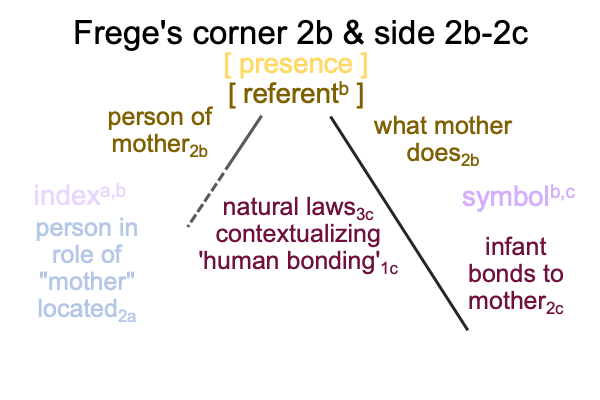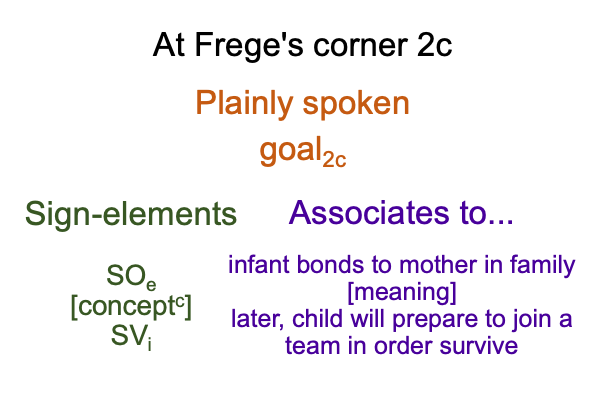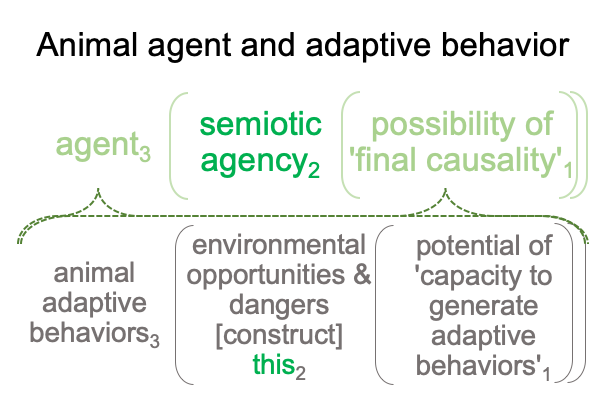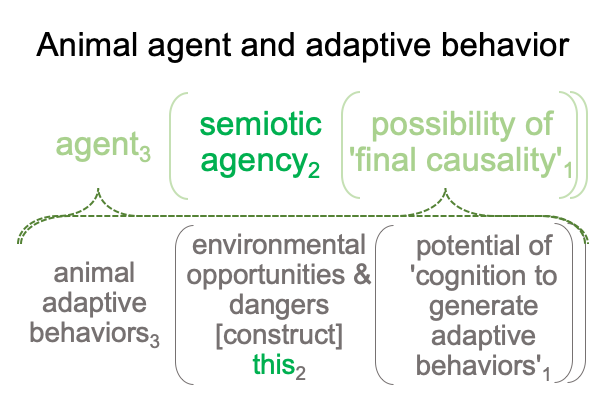1165 A newborn’s biosemiotic spiral completes with the exemplar sign.
What mother does2b (SVe) stands for infant and mother bonding2c (SOe) in regards to the natural laws of family3ccontextualizing the potential of ‘human bonding within the most fundamental social circle’2c (SIe).

1166 Then, what happens?
Everyone has observed what happens next.
No infant is satisfied with mother for long. Mom is crucial, but mom cannot perform the infant’s exploration of the world. Here, other members of the family come into play, each manifesting roles that add onto (and in the process, transform) the mother-infant bond. There is no one like mom. And, within a unique fusion of the material and immaterial, the infant grows.
1167 Personally, I would take the next spiral in the direction of the team. But, teams come much later. Surely, there must be a spiral for the other members of the family. The social circle of intimate friends contains around five people. So, in terms of the numbers, that might go next. The social circle of the team engages fifteen. And, that is where Professor Michael Tomasello begins his disquisition.
1168 Here is a picture of the start of the team spiral, which may well express (as various experts will insist) a bit of a jump.

Who goes from infant to team player?
1169 The nuclear family is one of the smallest social circles, numbering around 5. Intimate friends also make a small social circle, maybe around 5. Teams are typically three times larger, numbering 15. Bands are three times larger at 50. Communities are three times larger at 150. The human brain size correlates to group sizes of 150.
1170 The topic of social circles is examined in Comments on Clive Gamble, John Gowlett and Robin Dunbar’s Book (2014) Thinking Big, by Razie Mah, available at smashwords and other e-book venues.
1171 Section 18.2 is titled “Semiotic Brains Construct Cognitive Niches”.
The topic of neodarwinism is treated in this examination in points 0710 through 0752.
These points contain a technical definition of the term, “niche”. A niche is the potential of an actuality independent of the adapting species. Here, the adapting species are hominins. The actuality independent of the adapting species is thetriadic relation. Triadic relations include sign-relations, interscopes, judgments and mediations.
1172 At the end of section 18.2, the author draws upon the works of fellow biosemioticians. Our phenotype is due to genes that code for a body capable of semiotic agency. Hominins do semiotic agency like no other creature does semiotic agency. Our adaptations are both environmental (where the ecology challenges individual and social-circle as semiotic agents) and cultural (where the habits of one social circle challenge individual and other social-circles semiotic agents).
1173 Section 18.3 is titled “Cognitive Niche Construction Expresses an Evolutionary Sense of Purposefulness”.
This is a tricky claim. Adaptations to the environment should yield divergent evolution. Adaptations to culture should yield convergent evolution, insofar as culture exploits the potential of triadic relations.
The bottom line of human evolution?
All species in the Homo genus adapt to the potential of triadic relations (see The Human Niche, by Razie Mah, available at smashwords and other e-book venues).
1174 If the human niche is the potential of triadic relations, what is the meaning of the term, “cognitive niche”?
Spoken words are so curious.
Human evolution is both divergent (adaptations into an environmental niche) and convergent (adaptations into the niche of triadic relations).
Both engage cognition.
1175 The nature of agent proves crucial.
All living agents (even subagents)3 are normal contexts for semiotic agency2 emerging form (and situating) the possibility of ‘final causality’1.
Here is a picture for non-human agents. The fundamental nested form for agent occupies the top line.

The lower nested form is derivative.
“This2” in the lower nested form corresponds to “semiotic agency2” in the upper nested form.
1176 I can characterize the agent3 with a complementary normal context3. The holder of adaptive behaviors3 reminds this inquirer of the darwinism of “neodarwinism”, where natural selection3b brings the actuality of adaptation2b into relation to its niche1b. A niche1b contains the the capacity to generate adaptive behaviours1b.
1177 A new category-based nested form is born. The normal context of animal adaptive behaviors3 contextualizes the possibility of ‘being able to generate adaptive adaptive behaviors’1.
This nested form seems almost redundant, since it takes the actuality of one type of adaptation2 and moves it to the category of firstness as ‘a capacity for the animal to solve challenges’1.
What is it1 to solve an environmental or an ecological challenge?
Is it1 like the way that a slime mold figures out how to get through mazes? Yes and more. Since the slime mold does not have a brain, cognition is not part of the picture. But, for mammals and birds, cognition is in the picture. Mammals and birds can be remarkably clever. For these types of animals, cognition powers the capacity to generate adaptive behaviors1.
1178 Here is the comparison again, adjusting for importance of cognition.

1179 Now, I can wrap up the agent versus adaptive behavior comparison for mammals and birds.
The normal context of agent3 brings the actuality of semiotic agency2 into relation with the possibility of ‘final causality’1.
The normal context of animal adaptive behaviors3 brings the dyadic actuality, environmental opportunities and dangers [constructs] semiotic agency2, into relation with the potential of ‘cognition to generate adaptive behaviors’1.
Environmental opportunities and dangers are like matter.
Semiotic agency is like form.
1180 Purposefulness3((1)) covers the normal context3 of adaptive behavior3 and its potential1. ‘Capacity to generate adaptive behaviors’1 parallels ‘final causality’1.
What2 does purposefulness3((1)) actualize2?
It3((1)) actualizes a dyad, where environmental opportunities and dangers [construct] semiotic agency2.
In the subsidiary nested form, the environment explains animal semiotic agency.
